NOx-Free Leaching Methods for Efficient Silver and Aluminium Recovery from Crystalline Silicon Solar Cells
Abstract
1. Introduction
2. Materials and Methods
2.1. Selective Leaching of Aluminium with Sodium Hydroxide (NaOH) and Silver with Ammonia and Hydrogen Peroxide (NH3 + H2O2)
2.1.1. Aluminium Leaching with Sodium Hydroxide (NaOH)
2.1.2. Silver Leaching with Ammonia and Hydrogen Peroxide (NH3 + H2O2)
2.2. Simultaneous Leaching of Aluminium and Silver with Nitric Acid and Hydrogen Peroxide (HNO3 + H2O2)
3. Results
3.1. SEM-EDS Analyses of Untreated Solar Cells
3.2. Selective Leaching of Aluminium and Silver
3.2.1. Aluminium Leaching
3.2.2. Silver Leaching
3.3. Simultaneous Leaching of Aluminium and Silver with Nitric Acid and Hydrogen Peroxide
3.4. Leaching Efficiency
4. Discussion
5. Conclusions
Author Contributions
Funding
Institutional Review Board Statement
Informed Consent Statement
Data Availability Statement
Conflicts of Interest
References
- Jäger-Waldau, A. Snapshot of Photovoltaics−March 2025. EPJ Photovolt. 2025, 16, 22. [Google Scholar] [CrossRef]
- Li, W.; Cheng, S.; Yi, Z.; Zhang, H.; Song, Q.; Hao, Z.; Sun, T.; Wu, P.; Zeng, Q.; Raza, R. Advanced Optical Reinforcement Materials Based on Three-Dimensional Four-Way Weaving Structure and Metasurface Technology. Appl. Phys. Lett. 2025, 126, 33503. [Google Scholar] [CrossRef]
- Liu, H.; Li, J.; Yang, H.; Wang, J.; Li, B.; Zhang, H.; Yi, Y. TiN-Only Metasurface Absorber for Solar Energy Harvesting. Photonics 2025, 12, 443. [Google Scholar] [CrossRef]
- Chowdhury, M.S.; Rahman, K.S.; Chowdhury, T.; Nuthammachot, N.; Techato, K.; Akhtaruzzaman, M.; Tiong, S.K.; Sopian, K.; Amin, N. An Overview of Solar Photovoltaic Panels’ End-of-Life Material Recycling. Energy Strategy Rev. 2020, 27, 100431. [Google Scholar] [CrossRef]
- Farrell, C.C.; Osman, A.I.; Doherty, R.; Saad, M.; Zhang, X.; Murphy, A.; Harrison, J.; Vennard, A.S.M.; Kumaravel, V.; Al-Muhtaseb, A.H.; et al. Technical Challenges and Opportunities in Realising a Circular Economy for Waste Photovoltaic Modules. Renew. Sustain. Energy Rev. 2020, 128, 109911. [Google Scholar] [CrossRef]
- Kastanaki, E.; Giannis, A. Energy Decarbonisation in the European Union: Assessment of Photovoltaic Waste Recycling Potential. Renew. Energy 2022, 192, 1–13. [Google Scholar] [CrossRef]
- Weckend, S.; Wade, A.; Heath, G. End-of-Life Management: Solar Photovoltaic Panels; IRENA: Masdar City, United Arab Emirates; IEA-PVPS: Paris, France, 2016. [Google Scholar]
- Wang, X.; Tian, X.; Chen, X.; Ren, L.; Geng, C. A Review of End-of-Life Crystalline Silicon Solar Photovoltaic Panel Recycling Technology. Sol. Energy Mater. Sol. Cells 2022, 248, 111976. [Google Scholar] [CrossRef]
- Deng, R.; Chang, N.L.; Ouyang, Z.; Chong, C.M. A Techno-Economic Review of Silicon Photovoltaic Module Recycling. Renew. Sustain. Energy Rev. 2019, 109, 532–550. [Google Scholar] [CrossRef]
- Deng, R.; Zhuo, Y.; Shen, Y. Recent Progress in Silicon Photovoltaic Module Recycling Processes. Resour. Conserv. Recycl. 2022, 187, 106612. [Google Scholar] [CrossRef]
- Preet, S.; Smith, S.T. A Comprehensive Review on the Recycling Technology of Silicon Based Photovoltaic Solar Panels: Challenges and Future Outlook. J. Clean. Prod. 2024, 448, 141661. [Google Scholar] [CrossRef]
- Kuczyńska-Łażewska, A.; Klugmann-Radziemska, E.; Sobczak, Z.; Klimczuk, T. Recovery of Silver Metallization from Damaged Silicon Cells. Sol. Energy Mater. Sol. Cells 2018, 176, 190–195. [Google Scholar] [CrossRef]
- Ebong, A.; Chen, N. Metallization of Crystalline Silicon Solar Cells: A Review. In Proceedings of the 2012 9th International Conference on High Capacity Optical Networks and Enabling Technologies, HONET 2012, Istanbul, Turkey, 12–14 December 2012; pp. 102–109. [Google Scholar] [CrossRef]
- Choi, J.K.; Fthenakis, V. Economic Feasibility of Recycling Photovoltaic Modules. J. Ind. Ecol. 2010, 14, 947–964. [Google Scholar] [CrossRef]
- Maghraby, Y.R.; Ibrahim, A.H.; Tayel, A.; Mohamed El-Said Azzazy, H.; Shoeib, T. Towards Sustainability via Recycling Solar Photovoltaic Panels, A Review. Sol. Energy 2025, 285, 113085. [Google Scholar] [CrossRef]
- Padhamnath, P.; Ślęzak, M.; Karbowniczek, M. Disposing End of Life PV Modules–Reusing, Recycling and Upcycling. In Proceedings of the 40th European Photovoltaic Solar Energy Conference and Exhibition, Lisbon, Portugal, 18–22 September 2023. [Google Scholar] [CrossRef]
- Luo, M.; Liu, F.; Zhou, Z.; Jiang, L.; Jia, M.; Lai, Y.; Li, J.; Zhang, Z. A Comprehensive Hydrometallurgical Recycling Approach for the Environmental Impact Mitigation of EoL Solar Cells. J. Environ. Chem. Eng. 2021, 9, 106830. [Google Scholar] [CrossRef]
- Wang, J.P.; Lee, D.H.; Go, M.S.; So, E.K. A Study on the Wet Process Conditions That Affect the Selective Recovery of Si from Photovoltaic Cells by Using the Cavitation Effect. Metals 2022, 12, 222. [Google Scholar] [CrossRef]
- Kastanaki, E.; Lagoudakis, E.; Kalogerakis, G.; Giannis, A. Hydrothermal Leaching of Silver and Aluminum from Waste Monocrystalline and Polycrystalline Photovoltaic Panels. Appl. Sci. 2023, 13, 3602. [Google Scholar] [CrossRef]
- Ding, Y.; He, J.; Zhang, S.; Jian, J.; Shi, Z.; Cao, A. Efficient and Comprehensive Recycling of Valuable Components from Scrapped Si-Based Photovoltaic Panels. Waste Manag. 2024, 175, 183–190. [Google Scholar] [CrossRef]
- Theocharis, M.; Pavlopoulos, C.; Kousi, P.; Hatzikioseyian, A.; Zarkadas, I.; Tsakiridis, P.E.; Remoundaki, Ε.; Zoumboulakis, L.; Lyberatos, G. An Integrated Thermal and Hydrometallurgical Process for the Recovery of Silicon and Silver from End-of-Life Crystalline Si Photovoltaic Panels. Waste Biomass Valorization 2022, 13, 4027–4041. [Google Scholar] [CrossRef]
- Xu, X.; Lai, D.; Wang, W.; Wang, Y. A Systematically Integrated Recycling and Upgrading Technology for Waste Crystalline Silicon Photovoltaic Module. Resour. Conserv. Recycl. 2022, 182, 106284. [Google Scholar] [CrossRef]
- Yingzi, L.; Jiayi, G.; Xin, L.; Minglin, Z.; Oo, K.H.; Hongyu, C.; Yu, C.; Suiyi, Z.; Yang, Y. A New Route for Separating Impurities Al and Recovering Cu/Ag from Waste Solar Panels. J. Sustain. Metall. 2024, 11, 353–366. [Google Scholar] [CrossRef]
- Yousef, S.; Tatariants, M.; Denafas, J.; Makarevicius, V.; Lukošiūtė, S.I.; Kruopienė, J. Sustainable Industrial Technology for Recovery of Al Nanocrystals, Si Micro-Particles and Ag from Solar Cell Wafer Production Waste. Sol. Energy Mater. Sol. Cells 2019, 191, 493–501. [Google Scholar] [CrossRef]
- Click, N.; Teknetzi, I.; Tam, E.P.L.; Tao, M.; Ebin, B. Innovative Recycling of High Purity Silver from Silicon Solar Cells by Acid Leaching and Ultrasonication. Sol. Energy Mater. Sol. Cells 2024, 270, 112834. [Google Scholar] [CrossRef]
- Chen, W.-S.; Chen, Y.-J.; Lee, C.-H.; Cheng, Y.-J.; Chen, Y.-A.; Liu, F.-W.; Wang, Y.-C.; Chueh, Y.-L. Recovery of Valuable Materials from the Waste Crystalline-Silicon Photovoltaic Cell and Ribbon. Processes 2021, 9, 712. [Google Scholar] [CrossRef]
- Balaji Jadhav, N.; Gajare, O.; Zele, S.; Gogate, N.; Joshi, A. Current Status and Challenges in Silver Recovery from End-of-Life Crystalline Silicon Solar Photovoltaic Panels. Solar Energy 2024, 283, 113027. [Google Scholar] [CrossRef]
- Šleiniūtė, A.; Urbelytė, L.; Denafas, J.; Kosheleva, A.; Denafas, G. Feasibilities for Silicon Recovery from Solar Cells Waste by Treatment with Nitric Acid. Chemija 2020, 31, 137–145. [Google Scholar] [CrossRef]
- Punathil, L.; Mohanasundaram, K.; Tamilselavan, K.S.; Sathyamurthy, R.; Chamkha, A.J. Recovery of Pure Silicon and Other Materials from Disposed Solar Cells. Int. J. Photoenergy 2021, 2021, 5530213. [Google Scholar] [CrossRef]
- Mwase, J.M.; Wahl, S.; Meyer, S.; Yilmaz, D. Efficient Recovery of Silver and Aluminum from End-of-Life Photovoltaics: A Two-Step Leaching Approach. Processes 2024, 12, 2454. [Google Scholar] [CrossRef]
- Wahman, M.; Surowiak, A.; Forsberg, K.; Ebin, B.; Berent, K.; Szymczak, P. Preserving Silicon (Si) Purity through Efficient Aluminum (Al) and Silver (Ag) Extraction and Recovery from Solar Cell Waste. Sol. Energy Mater. Sol. Cells 2025, 287, 113601. [Google Scholar] [CrossRef]
- Zheng, R.; Luo, M.; Li, B.; Jia, M.; Zhang, H.; Liu, S.; Lu, Y.; Jiang, L.; Zhang, Z.; Liu, F. Eco-Friendly Recovery and Preparation of High Purity Nano Silver Powders from Retired Photovoltaic Solar Cells. Sep. Purif. Technol. 2025, 359, 130343. [Google Scholar] [CrossRef]
- Okamoto, F. Etching Solution for Silver. U.S. Patent 3860423A, 14 January 1975. [Google Scholar]
- Ramanauskaite, L.; Xu, H.; Griskonis, E.; Batiuskaite, D.; Snitka, V. Comparison and Evaluation of Silver Probe Preparation Techniques for Tip-Enhanced Raman Spectroscopy. Plasmonics 2018, 13, 1907–1919. [Google Scholar] [CrossRef]
- Solvay Chemicals. Hydrogen Peroxide Reaction Hazards; Solvay Chemicals: Brussels, Belgium, 2019. [Google Scholar]
- Zubas, A.R.; Pitak, I.; Denafas, G.; Griškonis, E.; Kruopienė, J. An Application of Solvent and Thermal Treatment to Recover Materials from Photovoltaic Module Encapsulated with Polyolefin Elastomer. Waste Manag. Res. 2024, 0734242X241305092. [Google Scholar] [CrossRef]
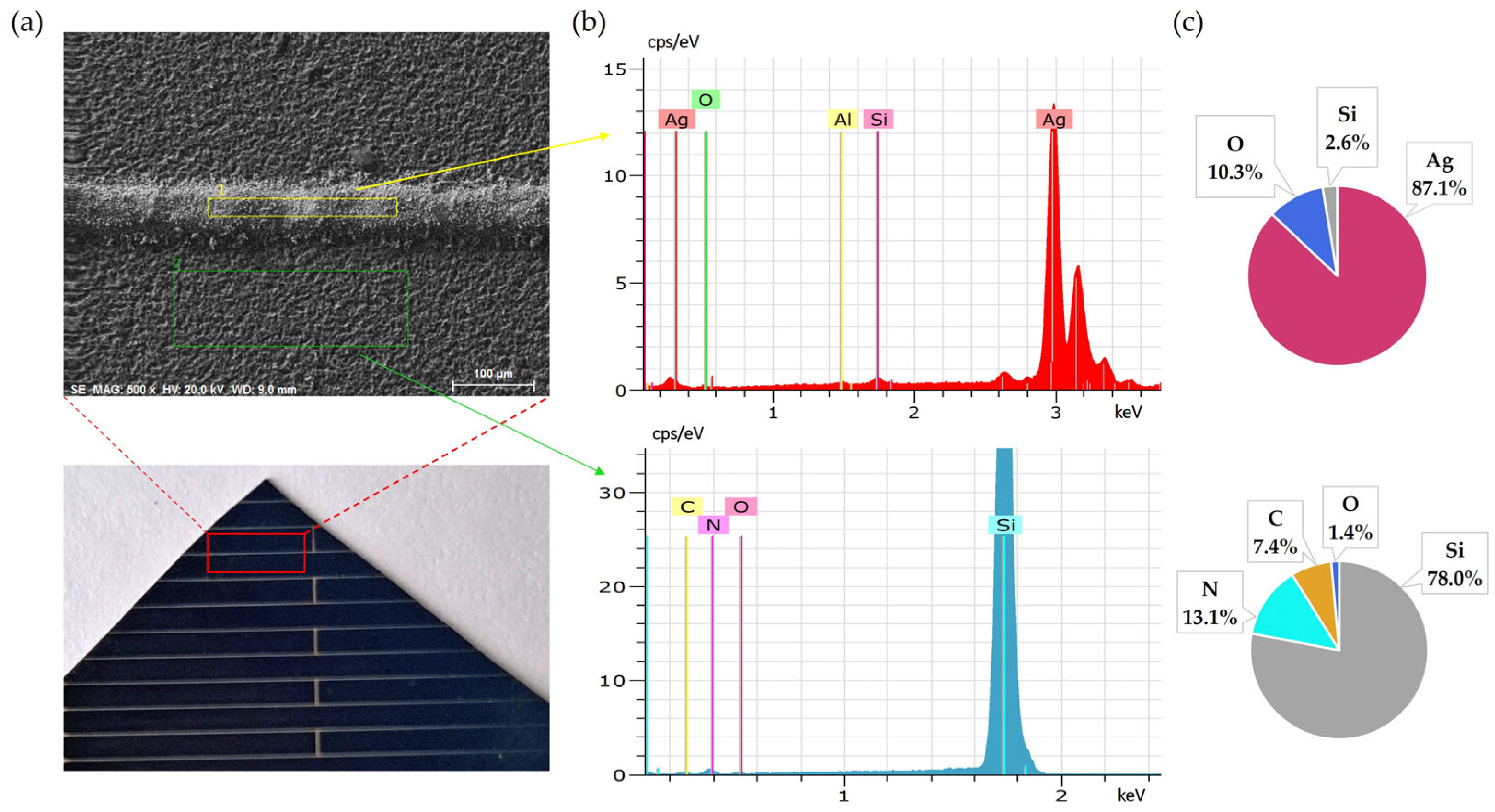

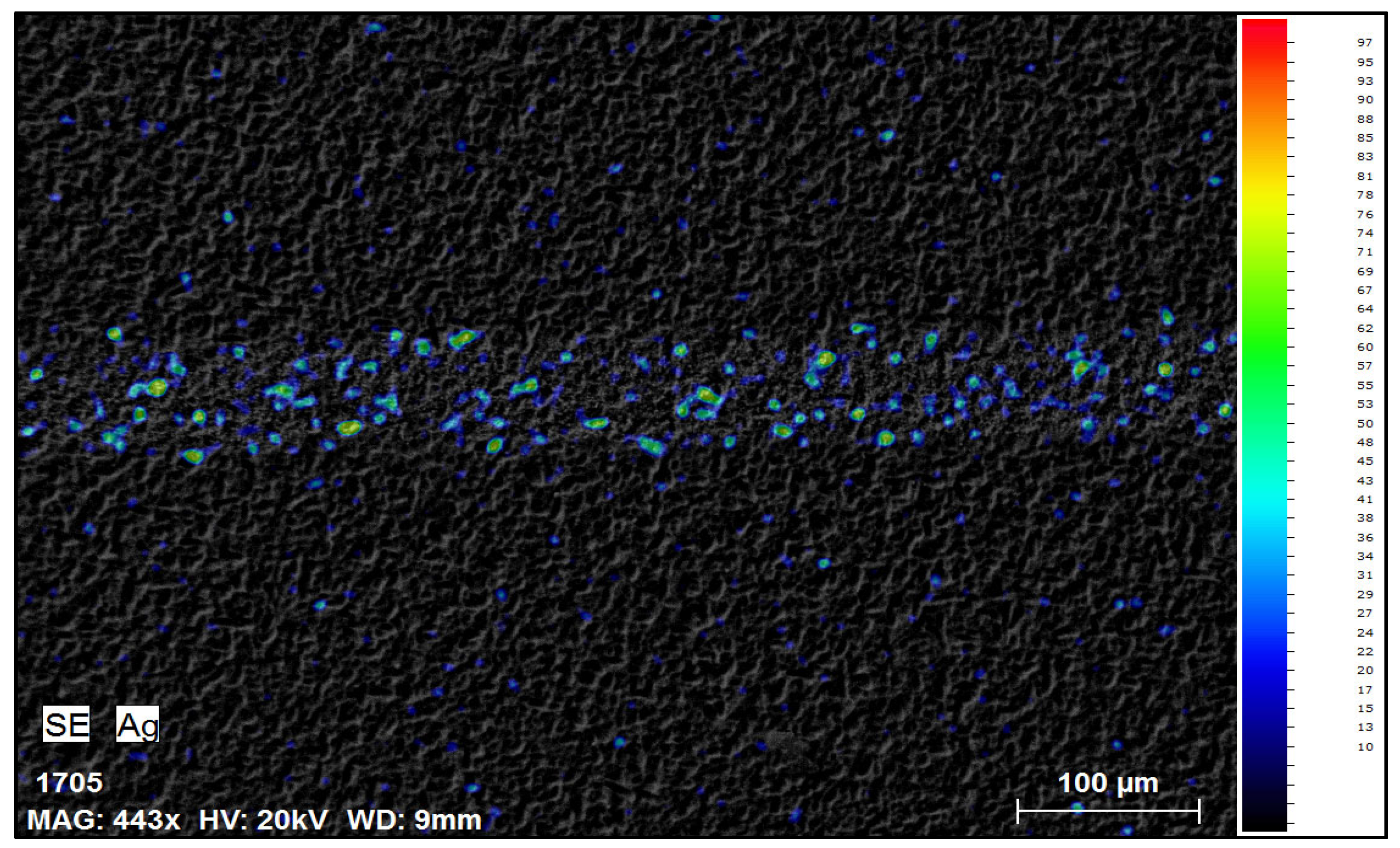
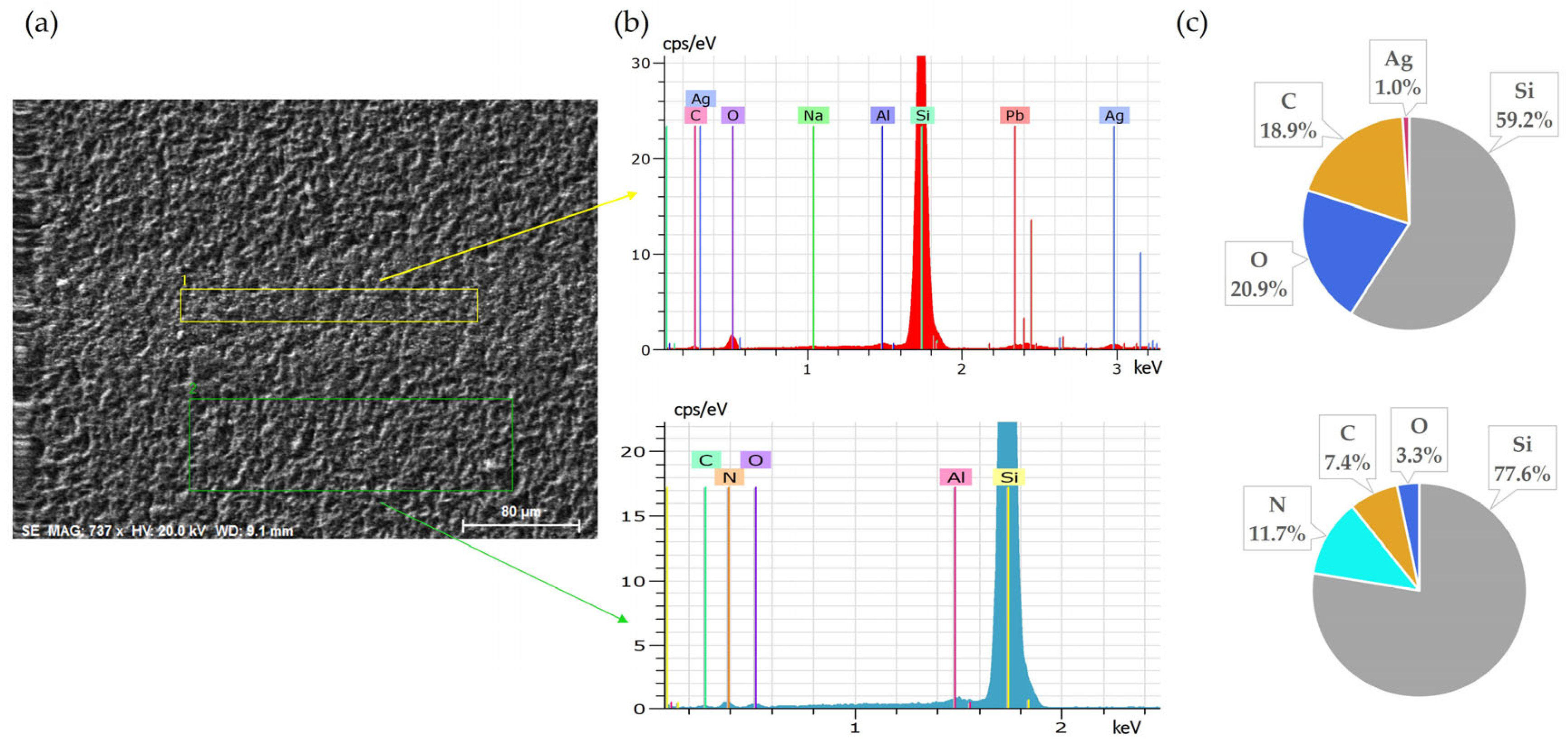
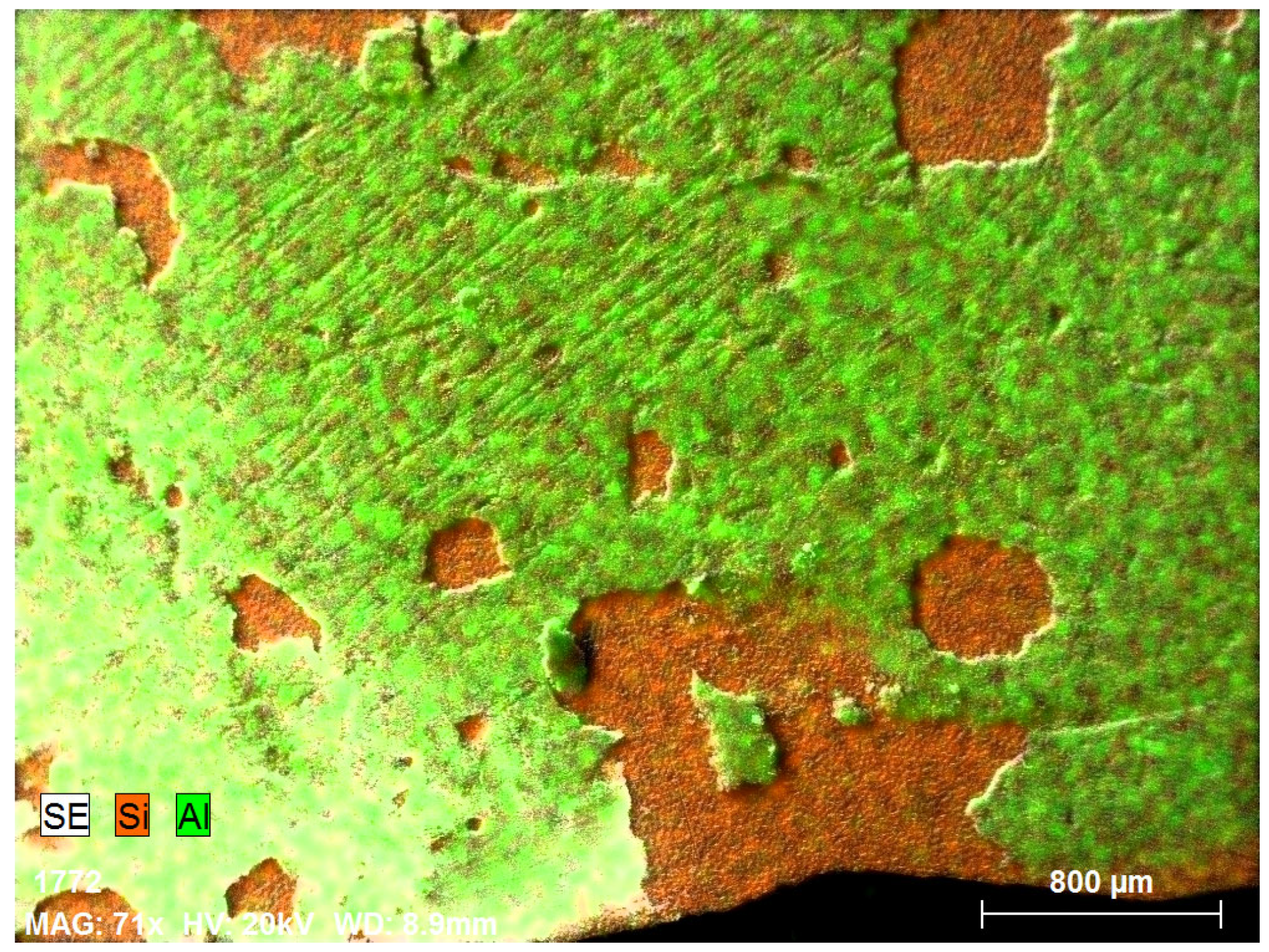

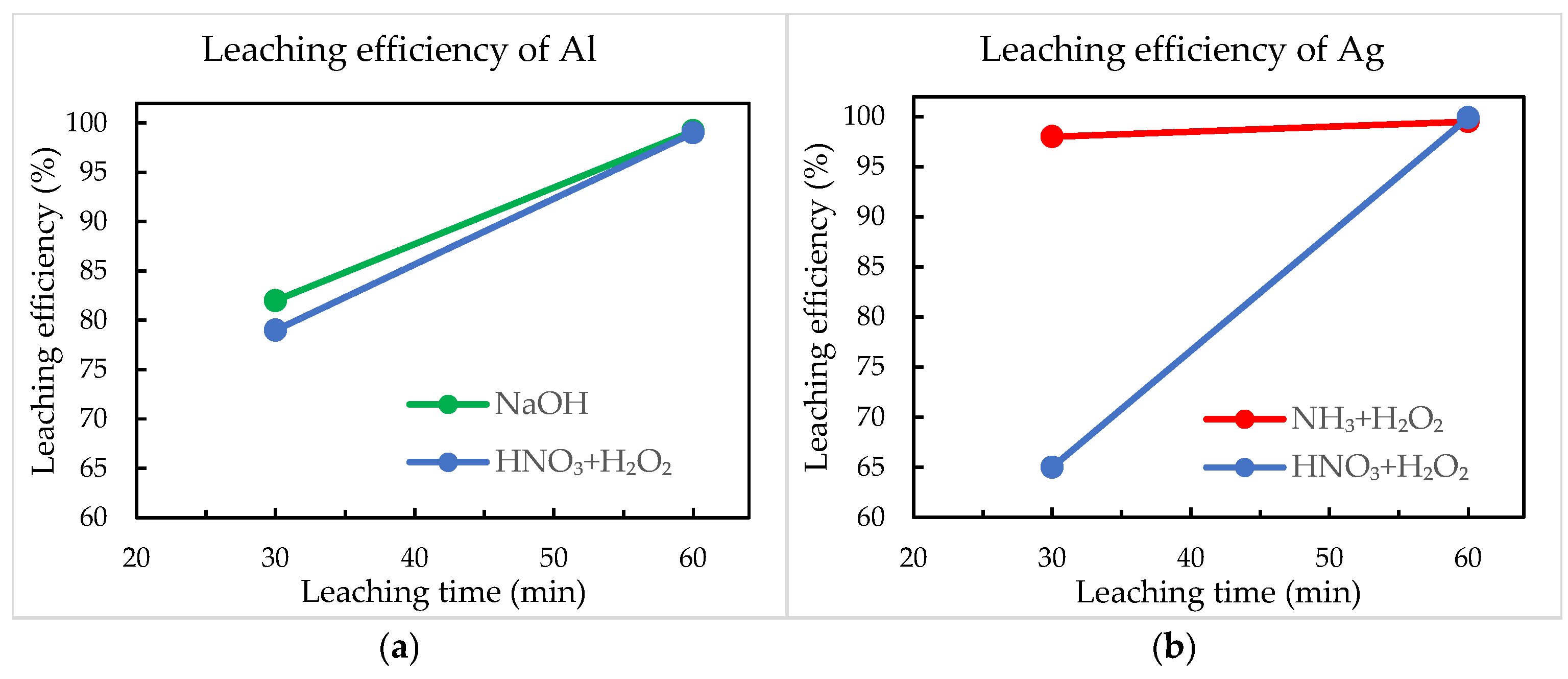
| Method | Reagents | NOx Emission | Leaching Efficiency | Complexity | Main Advantages | Main Limitations | Reference |
|---|---|---|---|---|---|---|---|
| Traditional HNO3 | HNO3 | Yes | 91% (Al) 99% (Ag) | Simple | Well known, rapid, universal | Significant NOx emission | [17,19,24,26] |
| H2SO4 + sonication | H2SO4 | No | 100% (Ag) | High | Common acid, room temperature | Need sonication, long (48 h) | [25] |
| C6H10O8 + H2O2 | C6H10O8; H2O2 | No | 97.4% (Ag) | Moderate | Eco-friendly, less hazardous | Higher costs, slower kinetics | [32] |
| This study: sequential | NaOH; NH3; H2O2 | No | 99% (Al) 99% (Ag) | Moderate | Mild conditions, rapid | Two-step process, H2 formation | This study |
| This study: simultaneous | HNO3; H2O2 | No | 99% (Al) 99.9% (Ag) | Moderate | Single step, rapid, effective | Requires careful H2O2 addition | This study |
Disclaimer/Publisher’s Note: The statements, opinions and data contained in all publications are solely those of the individual author(s) and contributor(s) and not of MDPI and/or the editor(s). MDPI and/or the editor(s) disclaim responsibility for any injury to people or property resulting from any ideas, methods, instructions or products referred to in the content. |
© 2025 by the authors. Licensee MDPI, Basel, Switzerland. This article is an open access article distributed under the terms and conditions of the Creative Commons Attribution (CC BY) license (https://creativecommons.org/licenses/by/4.0/).
Share and Cite
Zubas, A.R.; Griškonis, E.; Denafas, G.; Makarevičius, V.; Kriūkienė, R.; Kruopienė, J. NOx-Free Leaching Methods for Efficient Silver and Aluminium Recovery from Crystalline Silicon Solar Cells. Materials 2025, 18, 2668. https://doi.org/10.3390/ma18112668
Zubas AR, Griškonis E, Denafas G, Makarevičius V, Kriūkienė R, Kruopienė J. NOx-Free Leaching Methods for Efficient Silver and Aluminium Recovery from Crystalline Silicon Solar Cells. Materials. 2025; 18(11):2668. https://doi.org/10.3390/ma18112668
Chicago/Turabian StyleZubas, Aistis Rapolas, Egidijus Griškonis, Gintaras Denafas, Vidas Makarevičius, Rita Kriūkienė, and Jolita Kruopienė. 2025. "NOx-Free Leaching Methods for Efficient Silver and Aluminium Recovery from Crystalline Silicon Solar Cells" Materials 18, no. 11: 2668. https://doi.org/10.3390/ma18112668
APA StyleZubas, A. R., Griškonis, E., Denafas, G., Makarevičius, V., Kriūkienė, R., & Kruopienė, J. (2025). NOx-Free Leaching Methods for Efficient Silver and Aluminium Recovery from Crystalline Silicon Solar Cells. Materials, 18(11), 2668. https://doi.org/10.3390/ma18112668







